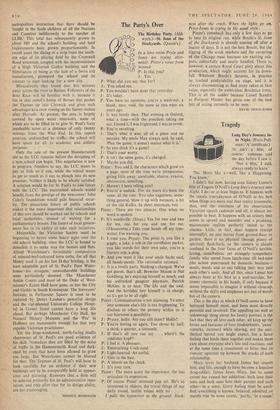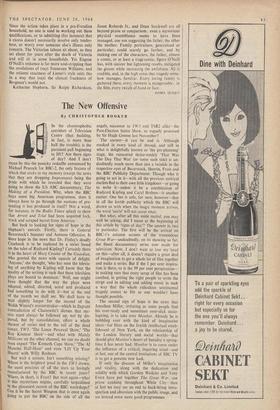Tragedy
Long Day's Journey in- to Night. (Paris-Pull- ' man; 'A' certificate.) 'IT isn't a film, of course,' someone said the day before I saw it.
'Not a film,' I said, always ready to learn.
`No. More like a—well, like a Happening.
You know.' .
I didn't, but now, having seen Sidney Lumet's film of Eugene O'Neill's Long Day's Journey into Night, I do; or at least begin to. It happens with the stately everydayness of O'Neill at his best when things are more real than reality (cinematic, this), and the exactness of his observation, Victorian speech cadences and all; is almost im- possible to bear. It happens with an artistry that seems to sprawl and meander and a prodding, microscopic realism perfectly suited to the cinema. Little, in fact, does happen (except internally), no one moves from ground-floor or garden, there is no physical (though plenty of spiritual) flash-back, so the camera is closely confined to the four faces of O'Neill's terrible, loving, cannibalistic yet strangely sympathetic family who spend from lunch-time till bed-time (the action punctuated by domestic business— meals, maids and so on) talking their way into each other's souls. And all this, since Lumet has always been at his best as a soul-searcher, be- comes cinematic in his hands, if only because it seems impossible to imagine it without close-up, without the shifts and emphases not just of words but of the camera.
This is the play in which O'Neill seems to have betrayed himself most, and been most directly personal and involved. The appalling (as well as redeeming) thing about his family portrait is the fact that they all love each other, all keep up the forms and fantasies of love (endearments, 'sweet' remarks, caresses) while sharing, not the anti- thetical hatred you might expect, but a fierce feeling that binds them together and makes them care about everyone else's fate and reactions, and at the same time a resentment so bitter that its rancour squeezes up between the cracks of each relationship.
Mary loves her husband James but resents him, and life, enough to have become a hopeless drug-addict; James loves Mary, but to some extent has caused her addiction; both love their sons and both sons love their parents and each other—in a sense. Every feeling must be quali- fied; everything is known, believed, admitted, or merely true `to some extent,' partly,"in a sense.'
Since the action takes place in a pre-Freudian household, no one is used to working out these qualifications, or to admitting (for instance) that a caress doesn't necessarily involve only tender- ness, or worry over someone else's illness only concern. The Victorian taboos sit about, as they sat about for years after the death of Victoria and still sit in some households. Yet Eugene O'Neill's reticence is far more soul-stripping than the revelations of (say) Tennessee Williams; and the reticent exactness of Lumet's style suits this • in a way that (say) the clinical frankness of Bergman's would not. Katharine Hepburn, Sir Ralph Richardson, Jason Robards Jr., and Dean Stockwell are all beyond praise or comparison : even a mysterious physical resemblance seems to have been managed, one son suggesting the father, the other the mother. Family portraiture, generalised or particular, could scarely go further, and by making one of the characters, the father, almost a comic, or at least a tragi-comic, figure O'Neill has, with sinister but lightening results, mitigated the gloom while increasing the awfulness. All is credible, and, in the high sense that tragedy some- how manages, familiar. Every loving family is gathered there, every moment is recognisable: in the film, every twitch of hand or face.
ISABEL QUIGLY



































 Previous page
Previous page